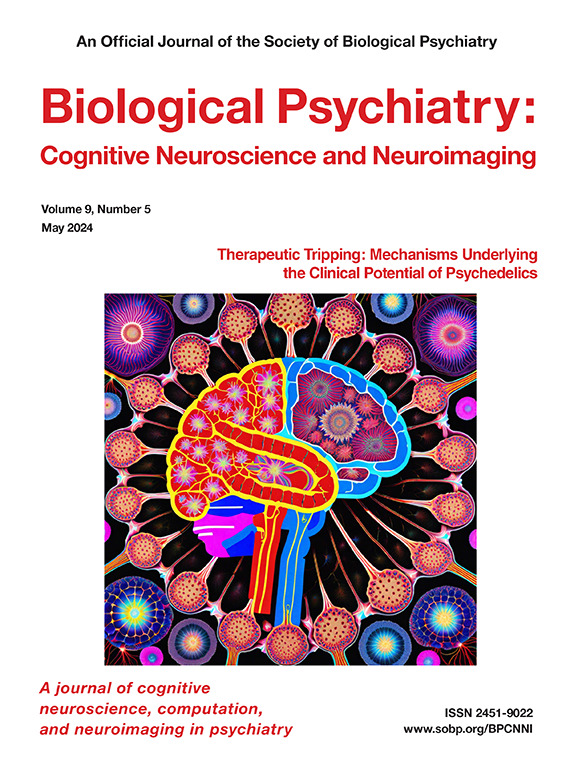Brain Age Is Not a Significant Predictor of Relapse Risk in Late-Life Depression
IF 5.7
2区 医学
Q1 NEUROSCIENCES
Biological Psychiatry-Cognitive Neuroscience and Neuroimaging
Pub Date : 2025-01-01
DOI:10.1016/j.bpsc.2024.09.009
引用次数: 0
Abstract
Background
Late-life depression (LLD) has been associated cross-sectionally with lower brain structural volumes and accelerated brain aging compared with healthy control participants (HCs). There are few longitudinal studies on the neurobiological predictors of recurrence in LLD. We tested a machine learning brain age model and its prospective association with LLD recurrence risk.
Methods
We recruited individuals with LLD (n = 102) and HCs (n = 43) into a multisite, 2-year longitudinal study. Individuals with LLD were enrolled within 4 months of remission. Remitted participants with LLD underwent baseline neuroimaging and longitudinal clinical follow-up. Over 2 years, 43 participants with LLD relapsed and 59 stayed in remission. We used a previously developed machine learning brain age algorithm to compute brain age at baseline, and we evaluated brain age group differences (HC vs. LLD and HC vs. remitted LLD vs. relapsed LLD). We conducted a Cox proportional hazards model to evaluate whether baseline brain age predicted time to relapse.
Results
We found that brain age did not significantly differ between the HC and LLD groups or between the HC, remitted LLD, and relapsed LLD groups. Brain age did not significantly predict time to relapse.
Conclusions
In contrast to our hypothesis, we found that brain age did not differ between control participants without depression and individuals with remitted LLD, and brain age was not associated with subsequent recurrence. This is in contrast to existing literature which has identified baseline brain age differences in late life but consistent with work that has shown no differences between people who do and do not relapse on gross structural measures.
脑年龄并非晚年抑郁症复发风险的重要预测因素。
简介与健康对照组(HC)相比,晚年抑郁症(LLD)在横断面上与较低的脑结构体积和加速的脑衰老有关。有关晚年抑郁症复发的神经生物学预测因素的纵向研究很少。我们测试了机器学习(ML)脑年龄模型及其与LLD复发风险的前瞻性关联:我们招募了LLD患者(n=102)和HC患者(n=43)参与一项为期2年的多地点纵向研究。LLD患者在病情缓解后4个月内入组。缓解的LLD患者接受基线神经影像学检查和纵向临床随访。2年中,43名LLD患者复发(REL),59名患者保持缓解(REM)。我们使用之前开发的ML脑年龄算法计算基线时的脑年龄,并评估了脑年龄组差异(HC vs. LLD,HC vs. REM vs. REL)。我们采用 Cox 比例危险模型来评估基线脑龄是否能预测复发时间:结果:我们发现,脑年龄在 HC 组与 LLD 组以及 HC 组、REM 组和 REL 组之间没有明显差异。脑年龄对复发时间的预测作用也不明显:与我们的假设相反,我们发现非抑郁对照组和LLD缓解患者的脑年龄没有差异,而且脑年龄与随后的复发没有关联。这与现有文献中发现的晚年基线脑龄差异不同,但与那些显示复发和未复发者在结构测量上没有差异的研究结果一致。
本文章由计算机程序翻译,如有差异,请以英文原文为准。
求助全文
约1分钟内获得全文
求助全文
来源期刊

Biological Psychiatry-Cognitive Neuroscience and Neuroimaging
Neuroscience-Biological Psychiatry
CiteScore
10.40
自引率
1.70%
发文量
247
审稿时长
30 days
期刊介绍:
Biological Psychiatry: Cognitive Neuroscience and Neuroimaging is an official journal of the Society for Biological Psychiatry, whose purpose is to promote excellence in scientific research and education in fields that investigate the nature, causes, mechanisms, and treatments of disorders of thought, emotion, or behavior. In accord with this mission, this peer-reviewed, rapid-publication, international journal focuses on studies using the tools and constructs of cognitive neuroscience, including the full range of non-invasive neuroimaging and human extra- and intracranial physiological recording methodologies. It publishes both basic and clinical studies, including those that incorporate genetic data, pharmacological challenges, and computational modeling approaches. The journal publishes novel results of original research which represent an important new lead or significant impact on the field. Reviews and commentaries that focus on topics of current research and interest are also encouraged.
 求助内容:
求助内容: 应助结果提醒方式:
应助结果提醒方式:


